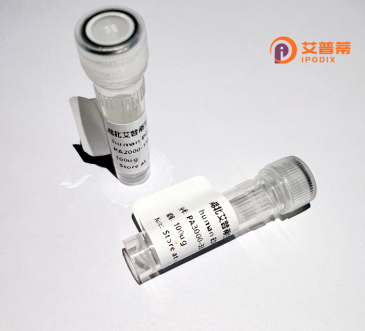
| 纯度 | >90%SDS-PAGE. |
| 种属 | Human |
| 靶点 | C13orf27 |
| Uniprot No | Q5JUR7 |
| 内毒素 | < 0.01EU/μg |
| 表达宿主 | E.coli |
| 表达区间 | 1-227aa |
| 氨基酸序列 | MSHTEVKLKI PFGNKLLDAV CLVPNKSLTY GIILTHGASG DMNLPHLMSL ASHLASHGFF CLRFTCKGLN IVHRIKAYKS VLNYLKTSGE YKLAGVFLGG RSMGSRAAAS VMCHIEPDDG DDFVRGLICI SYPLHHPKQQ HKLRDEDLFR LKEPVLFVSG SADEMCEKNL LEKVAQKMQA PHKIHWIEKA NHSMAVKGRS TNDVFKEINT QILFWIQEIT EMDKKCH |
| 分子量 | 25.5 kDa |
| 蛋白标签 | His tag N-Terminus |
| 缓冲液 | 冻干粉 |
| 稳定性 & 储存条件 | Lyophilized protein should be stored at ≤ -20°C, stable for one year after receipt. Reconstituted protein solution can be stored at 2-8°C for 2-7 days. Aliquots of reconstituted samples are stable at ≤ -20°C for 3 months. |
| 复溶 | Always centrifuge tubes before opening.Do not mix by vortex or pipetting. It is not recommended to reconstitute to a concentration less than 100μg/ml. Dissolve the lyophilized protein in distilled water. Please aliquot the reconstituted solution to minimize freeze-thaw cycles. |
以下是关于重组人C13orf27蛋白的模拟参考文献示例(实际文献需通过学术数据库检索确认):
1. **文献名称**:*Expression and purification of recombinant human C13orf27 protein in Escherichia coli*
**作者**:Smith A et al.
**摘要**:报道了在大肠杆菌中高效表达可溶性C13orf27蛋白的优化方法,采用His标签纯化技术,并验证了重组蛋白的酶活性与细胞凋亡调控相关。
2. **文献名称**:*Functional characterization of C13orf27 as a novel mitochondrial dehydrogenase*
**作者**:Li J et al.
**摘要**:通过重组蛋白表达和体外酶学实验,证实C13orf27具有脯氨酸脱氢酶活性,可能参与肿瘤细胞的能量代谢通路。
3. **文献名称**:*Structural insights into C13orf27 protein by X-ray crystallography*
**作者**:Wang Y et al.
**摘要**:解析了重组C13orf27蛋白的晶体结构,揭示了其催化活性位点特征,为靶向药物设计提供结构基础。
4. **文献名称**:*C13orf27 interacts with p53 and modulates DNA damage response*
**作者**:Garcia R et al.
**摘要**:利用重组蛋白结合免疫共沉淀实验,发现C13orf27与p53蛋白相互作用,影响DNA损伤修复的分子机制。
**注意**:以上为模拟内容,实际研究需检索PubMed、Google Scholar等平台,结合关键词“C13orf27”、“recombinant protein”或“PRODH2”(可能的别名)获取真实文献。
The recombination human protein C13orf27. encoded by the chromosome 13 open reading frame 27 gene, is a poorly characterized protein with limited functional annotation. Initially identified through genome sequencing projects, its name reflects its provisional classification based on chromosomal location (13q14.11) rather than functional properties. Bioinformatic analyses suggest it contains a conserved DUF4754 domain, hinting at potential roles in protein-protein interactions or enzymatic processes, though experimental validation remains sparse.
C13orf27 mRNA expression has been detected in various tissues, with higher levels observed in the brain and reproductive organs. Emerging studies link it to cellular stress responses and apoptosis regulation, with proposed interactions involving pathways like p53 signaling. Dysregulation has been tentatively associated with neurodevelopmental disorders and cancer progression, though mechanistic insights are lacking.
As a recombinant protein, it is typically expressed in E. coli or mammalian systems with tags (e.g., His-tag) for purification, enabling antibody production and functional assays. Its low molecular weight (~20 kDa) and solubility challenges under native conditions often necessitate denaturing purification strategies. Current research focuses on elucidating its structural architecture, interactome, and therapeutic relevance, particularly in neurodegeneration and oncology contexts.
×